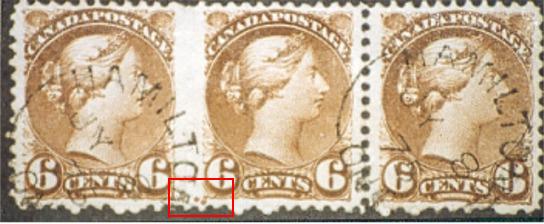
This strip of three is a First Ottawa Printing, first state from the 'A' plate positions 1,2, & 3. The left stamp has no position dot, the other two have two, one heavy, one lighter where the sidepoint sprung.
The Small Queens
Plate Characteristics
Up to about the end of 1879 in laying down each plate, the siderographer incised a position dot on the right of where each impression was to be rocked in on the printing plate. On the printed sheet this appears as a dot under the left corner of the stamp on all but the first vertical row – the reason the first row does not show this dot is because the dot under each stamp is actually the positioning point for the stamp to its left, so that while the tenth vertical row shows such a dot, and 90% of the stamps printed from these plates will have one, must be from an early plate – though not necessarily from an early printing. For example, only one plate was made for the Ten Cents value – in 1874 – so no Ten Cents is from the First Ottawa Period – and was in use both at Montreal and the end of the Second Ottawa Period. Yet another plate, one of the Six Cents, made probably in 1872, known as the “A” plate, was laid down with a transfer roller – the tool used to rock stamp impressions on to the printing plate – which had a loose side point – the device on the tool which was placed on the position dot to locate each impression in its correct position – and it sprang during the tremendous pressure exerted in rocking in, with the result that in its original state that plate has TWO dots, and, due to subsequent repairs, wound up with three and even on some positions, four dots. It was still in use in the 1890’s. However, most plates which showed a lower left position dot were out of use by the early 1880’s so its presence generally indicates either a First Ottawa or an early Montreal printing.
 |
This strip of three is a First Ottawa Printing, first state from the 'A' plate positions 1,2, & 3. The left stamp has no position dot, the other two have two, one heavy, one lighter where the sidepoint sprung. |
Plate Layouts. The early Small Queen plates were arranged ten subjects across by ten down on mild steel plates 11.5’’x 9.5” in size. These plates were not hardened at any time during their life making repair by re-entering the transfer tool on worn or faulty impressions a relatively simple matter. Imprints were placed centrally top, bottom and at both sides, and at least one counter (the stamp denomination e.g. TWO CENTS) to the left or right, and occasionally to both, side of the top imprint. In the case of the Ten Cents plate, one of its two counters – the left one – was the figure ‘10’. All the early plates were of this 10x10 format.
Since the probable reason for the reduction in size from Large Queen to Small was to speed up production – the price was fixed at 25 cents per 1000 – so it would not have been to get a reduced price, though in time it was reduced to 20 cents, it clearly occurred to the printers that things could be speeded up further by printing from two plates – of the same value (!) at a time. I suspect this actually happened because before long, for the lower values – Three Cents and below - a twin pane format was introduced consisting of two panes 10 x 10 placed horizontally side by side on plates 18” x 11.5” in size. At first both panes had the four imprints added and the usual single counters, sometimes toward the centre of the plate, and sometimes toward the edges, but in the later Montreal years the side imprints and occasionally the counters were dispensed with, particularly on One Cent plates. The Half-Cent plate was a twin pane type, but is unique for the time in that the panes were not separated by guillotine, but by perforating the centre gutter. Sheets and half sheets still extant may therefore either have or be devoid of selvedge on what would have been the side at the centre of the plate. This plate had no counters, but had four imprints, top, bottom and on the outside edge of each pane. By the end of the Montreal period twin plates had become the norm; the Six Cents plate made in 1887 but not brought into use until 1890 at the earliest was a twin plate while its four (I believe) predecessors were all single pane format.
In 1892 there was a further departure. Perforating machines could now cope with rows twenty across, so a number of One, Two and Three Cents plates were made 20 x 10 down using the same size metal. They had counters either side of the single top imprint, toward the outside edges of the sheet, and two bottom imprints symmetrically placed. The last four such plates were made in 1893 for the Eight Cents, which because its primary purpose was to pay postage AND registration combined, the portrait faces the opposite way to its predecessors to draw attention to its special nature, but these had neither counters nor imprints. Perhaps the printers had decided to save costs. Incidentally while they were equally valid for ordinary postage, one will find it just about impossible to find one on a cover that is not registered.